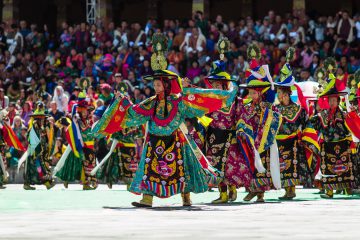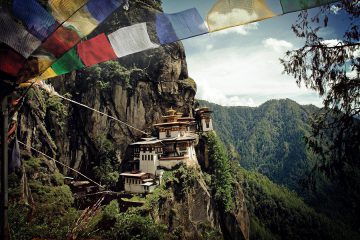Enjoy the best experience with 7 days 6 nights tour with dakini paradise
| DEPARTURE/RETURN LOCATION | Paro International Airport | ||||
| DEPARTURE TIME | Please arrive at least 2 hours before the flight. | ||||
| INCLUDED |
|
||||
| NOT INCLUDED |
|
Day 1
Day 1: Arrive Paro and Paro-Thimphu
(Separation: 54 km, evaluated driving time: 1 hr)
Arrive Paro.After migration customs you will be gotten by our delegate will’s identity your visit direct all through your visit.
At that point go to Thimphu which will take you through Chunzom (conversion of Pachu-the waterway moving through Paro valley and Wangchu – the stream coursing through Thimphu valley). In transit, appreciate strolling over a suspension extension to see fifteenth century press chain connect suspended over the Pa chu and furthermore stroll for around 10 minutes to visit Tachog Lhakhang (sanctuary), this fifteenth century sanctuary situated on the base of a mountain over the Pa chu on the Paro-Thimphu roadway.
In the wake of intersection Chunzom, the drive will take you along the Wangchu upto Thimphu city.
On landing in Thimphu, Check into your inn and unwind for at some point after early morming flight. After lunch visit the accompanying:
Arrow based weaponry Match (National Sport of Bhutan) at Changlimithang National Stadium. Ordinarily you will spot Bhutanese men playing arrow based weaponry amusement amid ends of the week or open occasions. Great chance to connect with neighborhood individuals.
Century Farmers’ Market (open from Thu-Sun just): Most of the Thimphu’s populace and numerous valley occupants meet on the clamoring end of the week advertise, held by the side of Wangchu River. An extensive variety of foodstuffs and neighborhood expressions and artworks are sold at the market, which keeps running from Friday evening till Sunday evening. A visit to the market gives awesome photograph openings, and also the opportunity to blend with nearby individuals.
Tashichhodzong, “the post of the superb religion”. This is the focal point of government and religion, site of the ruler’s position of authority room and seat of the Je Khenpo or Chief Abbot. Worked in 1641 by the political and religious unifier of Bhutan, Shabdrung Ngawang Namgyal, it was remade in the 1960s in conventional Bhutanese way, without nails or compositional plans. However somewhere else for picture taker’s joy.
Art Bazaar – A one stop place to witness Bhutanese culture and purchase Bhutan made workmanship and specialty item.
At night investigate Thimphu town all alone.
Supper and overnight at inn in Thimphu.
Day 2
Day 2: Thimphu-Punakha and Wangdue
Separation: 71 km, evaluated driving time: 2 ½ hours
After breakfast go to Punakha and Wangdue through Dochula Pass 3140 m).
At Dochula, free spring sky, you can appreciate the all encompassing perspective of the Himalayan Mountain ranges. You can take photographs at the excellent 108 chortens.
You will likewise visit Druk Wangyal Lhakhang (religious community) which was worked by Ashi Dorji Wangmo Wangchuck ( the Queen Mother of Bhutan).
You will have refreshment (tea/espresso and tidbits) at Dochula Pass Cafeteria and afterward travel onto Punakha.
In transit, stop for customary Bhutanese lunch at a farmhouse Lobesa town. After lunch stroll through paddy fields for around 20 minutes to visit the Devine Madman’s Monastery-Chhimi Lhakhang, broadly known for its ripeness sanctum, where one can get an extraordinary fruitfulness favoring.
At that point stroll over customary canteliver extension to visit the Punakha Dzong, situated on the island of the Pho – Chu (male stream) and the Mochu (female waterway).
At that point stroll for around 15 minutes to one of the longest suspension connect in Bhutan spreading over 350 m and roosted high over the exceptionally quick Pho chu (male waterway). Hung with petition hails ,the extension interfaces the town of Punakha and Punakha Dzong.This connect is primarily utilized by local people from the town situated on the opposite side of the stream as an alternate route to Punakha Dzong.
At night visit Sangchhen Dorji Lhuendup Lhakhang Nunnery and appreciate the stunningly wonderful perspective of Punakha and Wangdue valleys from that point. This beautiful place gives you a decent open door for photography.
Supper and overnight at inn in Punakha.
Day 3
Day 3: Punakha short nature climb and touring and Punakha-Phobjikha Valley
Separation: 68km, evaluated driving time: 3 hours ( because of poor street conditions)
After breakfast go through upper Punakha valley and take a recreation walk going through suspension bridgeand through paddy fields to the delightful Khamsum Yuelley Namgyal Lhakhang . The relaxed stroll up to the sanctuary would take around 60 minutes. Visit the sanctuary and furthermore appreciate the amazingly delightful view from that point.
After lunch go to Phobjikha valley through Wangdue. Phobjikha valley is a piece of the delightful Jigme Singye Wangchuck National Park (some time ago known as Black Mountains National Park), one of Bhutan’s most imperative nature havens. Each winter it is home to a rush of 300 uncommon and imperiled dark necked cranes. The encompassing slopes and mountains are home to roaming shepherds and yak-h erders. This is a standout amongst the most remote and untouched districts in Bhutan.
On landing in Phobjikha register with your inn and at night visit a farmhouse which gives you into the lifestyle of individuals of Phobjikha valley.
You may appreciate common Bhutanese supper.
Overnight at inn in Phobjikha valley.
Day 4
Day 4: Phobjikha Sightseeing and Phibjikha-Thimphu
Separation: 135 km, evaluated driving time: 5 hours
After breakfast visit Gangtey Monastery and take a short climb from Gangtey Monastery along the Gangtey Nature Trail getting a charge out of tremendous perspective of a few towns in Phobjikha valley. You will end your climb at Black Necked crane focus and visit the Black necked crane focus (cranes will begin moving to this territory by Novermber). From dark crane focus take short stroll through fields and farmhouses where you can have free association with nearby individuals and visit their homes.
After lunch go to Thimphu a through Nobding town which is around 45 minutes drive from Phobjikha valley and furthermore through Wangdue Phodrang and Dochula Pass.
You are required to arrive Thimphu late at night.
On landing in Thimphu a register with your lodging.
Supper and overnight at inn in Thimphu.
Day 5
Day 5: Thimphu Sightseeing and Thimphu-Paro and Paro touring Tour
After breakfast Thimphu city visit and visit the accompanying:
The National Memorial Chorten (stupa) which was developed in 1974 as a dedication for the third King of Bhutan, King Jigme Dorji Wangchuck, who is generally viewed as the father of present day Bhutan. The term ‘chorten’ actually implies ‘ seat of confidence’ and Buddhists frequently call such landmarks the ‘Brain of Buddha’. Meet the elderly age in circumambulation, particularly in the nighttimes, at the National Memorial Chorten.
Buddha Point/Kuenselphodrang: This enormous Buddha statue is 51.5 meters in tallness and it is one of the biggest statues of Buddha on the planet. The statue is made of bronze and is overlaid in gold. The royal position that the Buddha Dordenma sits upon is an extensive contemplation lobby.
The Buddha Dordenma is situated on a slope in Kuenselphodrang Nature Park and disregards the Southern access to Thimphu Valley. The statue satisfies an old prediction going back to the eighth century A.D that was found by Terton Pema Lingpa (Religious Treasure Discoverer) and is said to exude an air of peace and bliss to the whole world.
Changzamtok Weaving Center to watch ladies weaving unpredictable examples of brilliant silk and cotton materials into shawls, scarves and conventional Bhutanese dresses.
The School of Traditional Painting of Arts and Crafts where understudies embrace a six-year course on the 13 conventional expressions and specialties of Bhutan.
Customary Bhutanese paper making plant. The high quality paper making in Bhutan originated from the deep rooted custom started in eighth century of Bhutanese history. The carefully assembled paper constitutes as profitable National legacy of Bhutanese social personality and is safeguarded through every one of the ages.
After lunch go to Paro and drive to parking garage close Paro Dzong and stroll over customary Cantilever Rimpung connect which is most seasoned extension in Bhutan to visit Paro dzong Paro Rinpung Dzong (post), worked in 1645 to protect the valley against Tibetan intruders. The Dzong is currently being utilized as an organization focus and school for priests. From the Dzong you will stroll down to Rimpung Bridge.
At that point visit National Museum, housed in the Ta Dzong (watchtower). Here is an interesting gathering of ancient rarities which furnish you with an awesome understanding to the rich culture and legacy of the Kingdom of Bhutan.
At night investigate Paro town all alone.
Supper and overnight at lodging in Paro.
Day 6
Day 6: A Day Hike to Taktsang Ghoempa (Tiger’s Nest Monastery)
After breakfast, drive for around 20 minutes to the base of Taktsang Monastery and afterward climb up to Taktsang Monastery, otherwise called ‘Tiger’s Nest’. The stroll up to the perspective will take around 1 – 1 ½ hrs relying upon your wellness and from View Point you will appreciate a stupendous perspective of the religious community sticking to the side of the bluff. Stop for refreshment at the View Point Cafeteria. Take photographs with incredible perspective of Taktsang behind you.
At that point walk additionally up to the cloister which will take around 60 minutes. In the wake of going by the religious community, walk downhill back to the street in transit stop for lunch at the view point cafeteria and afterward walk promote downhill to the street point.
Following visit Kichu temple,one of the 108 sanctuaries worked in the seventh century by the Tibetan King Songsten Gampo.
At that point visit a Farmhouse in Paro Valley and a visit to a farmhouse offers a decent look into the way of life of a rancher.
At night unwind in the Traditional Bhutanese Hotstone shower at a farmhouse in Paro valley.
Customary Hotstone shower: A conventional Bhutan hot stone shower utilizes waterway shakes that specialists put in water where they split and steam, discharging key minerals and mitigating profound set hurts.
You will likewise observe around within the customary Bhutanese house.
You will appreciate customary Bhutanese supper with the relatives of the house.
Overnight at Tashi Namgay Resort or comparative in Paro.
Day 7
Day 7: Paro flight
After early breakfast your visit direct from Dakini Paradise will escort you to the Paro airplane terminal for your Drukair or Bhutan Airlines flight out of Paro.




Tour Reviews
There are no reviews yet.
Leave a Review